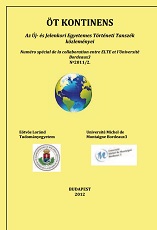Les Hongrois ayant rejoint le Mouvement européen en 1948
The Hungarians joining the European Movement in 1948
Author(s): Gergely FejérdySubject(s): History
Published by: Eötvös Loránd Tudományegyetem, Új-és Jelenkori Egyetemes Történeti Tanszék
Keywords: refugies; European Movement; European Unity; European Construction; Hungarian Federalists; Congress of Hague; Hungary; Iron Curtain; Cold War
Summary/Abstract: At the beginning of the Cold war, a large part of the Hungarian elite constrained to emigrate chose to join the Hungarian Committee of European movement. This Committee, which was created in 1948 following the Congress of Hague, was also one of the national councils of the Organization set up and chaired by Ducan Sandys. Without an exhaustive list of its members, it suffices to mention only a few illustrative names: Pál Auer, Gábor Apor, Gyula Dessewffy, Sándor Márai, Károly Payer, György Bakach-Bessenyey etc. Most of these personalities joined this European platform because they saw it as an efective instrument of international publicity and mobilisation in the struggle against the Soviet occupation of the Hungary. These prominent representatives of Hungarian literary and political traditions also considered their participations in the activities of that Committee an opportunity for the demonstration of Hungarian interests in European construction. From 1950 the enthusiasm subsided and the Hungarian Committee of the European movement became less active, it nevertheless maintained its considerable intellectuel strength up to the end of the 1950s. Through the European movement, especially the Commission of Central and Eastern Europe in connection with the Council of Europe, and by his Vice-President Pál Auer, Hungarian ideas on European unity could be disseminated, though discretely, within influential Western circles despite the existense of the Iron Curtain.
Journal: ÖT KONTINENS
- Issue Year: 2011
- Issue No: 2
- Page Range: 129 - 140
- Page Count: 1
- Language: French

